The opening arc of the sixth season of Star Trek: Deep Space Nine is one of the most ambitious storytelling experiments in the history of Star Trek.
To be fair, it is not entirely unique. In some ways, it mirrors the storytelling arc that unfolded across Star Trek II: The Wrath of Khan, Star Trek III: The Search for Spock and Star Trek IV: The Voyage Home. Both Kirk and Sisko are separated from their home and from their first officer and from their iconic command, before eventually finding their way to reunite with both. Obviously, a three-film trilogy is distinct from a six-episode arc, even before talking about the tonal, thematic and plotting differences between those three iconic films.
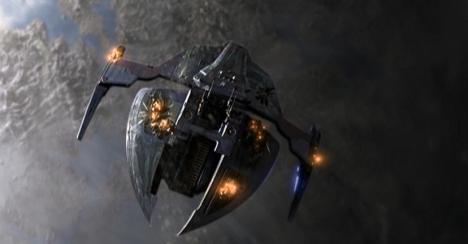
The Jem’Hadar warship that fell to Earth…
More than that, the success of the this arc would embolden the production team. They would attempt an even more audacious experiment to close out the seventh season of the series. The sixth season opened with six interconnected stories following the Cardassian reoccupation Terok Nor, building to Sisko’s retaking of the station. The seventh season pushes that even further, with a much more tightly integrated ten-episode arc that attempts to tell a single cohesive story. It is an even bolder creative decision than this arc, committing more strongly to the premise.
Ronald D. Moore’s departure from Star Trek: Voyager early in its sixth season would turn these experiments in serialisation into an evolutionary dead end for the franchise. It would be four years before Rick Berman and Brannon Braga would attempt to a tell a story on that scale. Indeed, faced with declining ratings and the spectre of cancellation, Star Trek: Enterprise attempted what was (on the surface at least) the even more ambitious attempt at a season-long arc across the entirety of the third season.

Between a rock and a hard place.
Still, the six-episode arc that opens the sixth season of Deep Space Nine remains an impressive moment in the history of the franchise. Indeed, contrasted with the sprawling ten-episode arc that closes the series or the season-long arc on Enterprise, it could reasonably be argued that this six-episode stretch does a stronger job of balancing the integrity of individual episodes with the demands of the larger arc. These six episodes are all very strongly connected to one another, with a clear sense of story and character progression, but they also retain their own identities within that.
Rocks and Shoals might be the best example of this, an episode that delicately balances its own storytelling with the needs of the arc as a whole. Rocks and Shoals is at once a great episode in its own right and an essential part of a much larger story.

Express elevator to hell.
The sixth season of Deep Space Nine was controversial, for a number of different reasons. Most obviously, the whole idea of the Dominion War represented a challenge to Gene Roddenberry’s utopian ideal. Many fans, and some members of the larger Star Trek family, took exception to the idea of building a Star Trek series around a large-scale intergalactic conflict. This was especially the case among the more traditionalist segments of the base, those who tasked themselves with curating the legacy of Gene Roddenberry.
However, there were other tensions at play at this point in the run. The six-episode arc at the start of the sixth season comfortably pushes Deep Space Nine into a very serialised approach to storytelling. This represented a challenge to a franchise that had long prided itself on its episodic storytelling, the cornerstone of its success in syndication. The idea was that most Star Trek episodes could be enjoyed in any order by anybody, rendering the franchise accessible to those who might watch casually at home without needing to catch every episode.
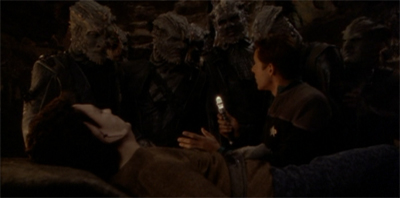
No guts, no glory.
To be fair, it is not as clear-cut as that made it sound. The franchise had done any number of impressive two-part stories; Deep Space Nine had even opened its second season with an ambitious three-parter in The Homecoming, The Circle and The Siege. However, the story that opens the sixth season cannot readily be described as a “six-parter.” Most obviously, Rocks and Shoals and Sons and Daughters stand alone, while Favour the Bold and Sacrifice of Angels are a pseudo-two-parter.
These writers had been trying to sneak long-form storytelling into the franchise for a long time. Writer Ronald D. Moore got into a debate with producer Rick Berman over the open-ended closing scenes of Sins of the Father, the story that kick-started the Klingon story arc that would run over ten seasons of television. Similarly, Moore found himself facing opposition from Gene Roddenberry when he wrote Family about Jean-Luc Picard trying to come to terms with the events of The Best of Both Worlds, Part I and The Best of Both Worlds, Part II.

Pooling resources.
Deep Space Nine spent its first five years inching closer and closer towards a more serialised type of storytelling. Character threads were developed across a number of episodes, while major events were allowed to have significant repercussions. Kira Nerys found herself drawing closer to the Federation in stories like Past Prologue, Progress and In the Hands of the Prophets. Winn Adami was introduced in In the Hands of the Prophets, and her scheming to become Kai would pay off in The Collaborator.
Indeed, Deep Space Nine‘s interest in long-form storytelling allowed it to draw a more complex picture of twenty-fourth century politics. The failed Obsidian Order attack on the Founders in Improbable Cause and The Die is Cast led directly to the Klingon invasion in The Way of the Warrior, which in turn paved the way for the Cardassians to join the Dominion in In Purgatory’s Shadow and By Inferno’s Light. Events tended to resonate across various episodes, with decisions having long-term consequences.
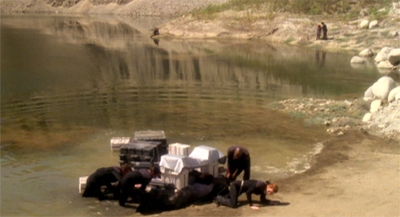
Floating ideas.
Even allowing for these experiments, there was a massive leap in the series’ commitment to long-form storytelling between the fifth and sixth seasons. In the late fifth season, there was a clear lag between the stories where events happened and the stories in which the consequences of those events played out. After Cardassia joined the Dominion in By Inferno’s Light, episodes like Doctor Bashir, I Presume, A Simple Investigation and Business as Usual largely glossed over it. It was not explored until Ties of Blood and Water, four episodes later.
In contrast, the stories in the early sixth season need to be more strongly integrated with one another. So Rocks and Shoals picks up directly after A Time to Stand, with the crew trapped on a disabled Jem’Hadar ship. Then Sons and Daughters picks up directly after Rocks and Shoals, assuming that the crew have been rescued by the Klingons. This is to say nothing of how carefully the events in Behind the Lines need to tie into the closing two-parter of Favour the Bold and Sacrifice of Angels.

“Don’t worry, Dax. You’ll make it until at least the end of the season.”
This plan was ambitious, but it was also controversial. In the late nineties, syndication was still the primary target market for long-running television shows. Any series wanting to endure (and earn money) after its initial broadcast relied upon syndication deals with local and international networks. There was a lot to be said for syndication as an essential part of the television life cycle, even beyond the obvious financial considerations. In some ways, syndication had helped the original Star Trek find an audience after it was cancelled, keeping the franchise alive.
While Deep Space Nine was on the air, syndication was the most likely long-term future for a television series. Star Trek and other genre shows were available on VHS, but a combination of cost, quality and space made it a model unlikely to offer long-term sustainability. To be fair, home media was on the cusp of two technological revolutions that would revolutionise the way that audiences consumed television shows, but online streaming and digital versatile discs were largely aspiration at this moment in time.

Bajoran Netflix’s autoplay feature is a monster.
A Time to Stand aired in September 1997. The first consumer DVD player had only been released six months earlier. Warner Brothers were only just announcing releases of their back catalogue in the format. Sales were sluggish; numbers would only really pick up in 1999, when Titanic became the first DVD to sell more than a million units and The Matrix became the first DVD to sell more than one-point-five million units. The release of Star Trek: Generations and Star Trek: First Contact in the format was still one year away.
As the six-episode arc aired, there were no public plans to release Deep Space Nine on DVD. The series would not see its first DVD release until February 2003, more than three years after it ended. Even accounting for the trend toward serialisation in late nineties series like The X-Files or Buffy: The Vampire Slayer or Babylon 5, the idea of a highly-serialised syndicated science-fiction adventure series ran counter to the expectations and experience of executives. After all, Star Trek had traditionally been a narrative conservative franchise.

What vial behaviour.
As such, the writing staff on Deep Space Nine faced considerable challenges, not just from the fanbase invested in the franchise mythology. There was considerable resistance from inside the Star Trek family. However, Ira Steven Behr was committed to the idea of long-form storytelling:
Well, we had talked about it for years, the thought of, “If only we could be more serialized.” Look, we were drunk on wine and women. No. I felt the end coming. Obviously, we all did. We knew it’d be seven years and out. It was just, “Look, what do we want to do? Whatever it is, we should do it now.” Someone asked me on the last day of shooting why I was hanging around so long and I think the line I said was, “I have the rest of my life not to be here. So while I’m here, I’m going to stay until the end.” So it was the same thing. “What do we want to do?” One of the things we wanted to do was experiment with serialization and with the kind of space-opera war that spoke to a lot of the mythologies the show had built up. I thought we could do it. I knew we could do it. And then it became horse trading. I don’t even remember how many episodes we did, but I know we wanted more. Rick (Berman) and I went back and forth. Nothing terrible. No fights or anything like that. But we horse traded a bit and we came up with whatever it was.
Ira Steven Behr is a phenomenal Star Trek producer, like Michael Piller and Gene L. Coon before him. As with Piller and Coon, a large part of Behr’s brilliance lies in his willingness to push Star Trek in new directions; the franchise, and not just the characters, must boldly go.
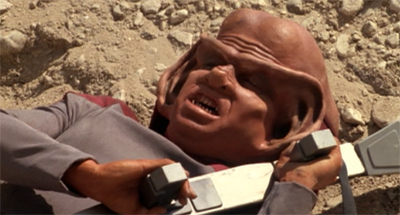
Nog the battle to the strong.
Deep Space Nine has one of the best television writing staffs in the history of the medium, a fact frequently overlooked owing to its status as a “genre” show. More than that, Deep Space Nine was staffed by an assortment of writers who clearly relished working together and bouncing ideas off one another. Behr clearly led the writers’ room, but he also trusted his staff to do their jobs. Deep Space Nine owes almost as much to Moore, Wolfe, Beimler and Echevarria as it does to Behr.
A lot of that was down to the freedom that existed within the writers’ room. Part of that was a rebellion against the more conservative tendencies on The Next Generation, which Behr described as “the Connecticut of Star Trek.” Moore has talked about how the production team repeatedly tried to strain against the confines of “the Roddenberry Box.” Of course, the Star Trek franchise owes a great deal to The Next Generation, but innovation and iconoclasm are an essential part of creative evolution.

There were many casualties on the path to serialisation.
There really weren’t any. I mean, we really felt free to go as far as we… Ira certainly would let us go wherever we wanted for a first draft, and then kind of figure out what worked, what didn’t, and then fight the battle with Rick if you had to. But I don’t really remember there being a stricture about what we could, and could not, do there.
This attitude stands in stark contrast to the mood on Voyager, where Michael Piller had been forced to resign at the end of the second season and where there were very clear creative restrictions imposed upon otherwise adventurous writers like Brannon Braga and Joe Menosky.

That sinking feeling.
Unlike Voyager, Deep Space Nine was airing in syndication and so was not subject to the whims of a single broadcaster. The biggest obstacle for Deep Space Nine was frequently the studio and the more conservative leanings of executive producer Rick Berman. Berman had been working on the franchise since the earliest days of The Next Generation, and tended to see himself as the custodian of the franchise. He brought a level of professionalism and stability to the franchise, particularly in those early years when The Next Generation needed to establish itself.
Behr also demonstrated a canny knack for managing upwards. He was a great writer, but one of his strengths as a producer lay in his ability to manage upwards, fighting to ensure that that his staff were afforded the opportunity to do their best work. Although there is a tendency to exaggerate the extent of their disagreements, this could occasionally bring Behr into conflict with Berman. Berman was anxious that Deep Space Nine adhere as closely to the Star Trek template as possible. Behr wanted to break the mould.

Caving under pressure.
The Dominion War was understandably a source of much debate between the two creative figures, with Berman strongly objecting for reasons both philosophical and pragmatic:
The whole idea of the Dominion Wars, the idea that Ira wanted an arc that was going to last a season or perhaps longer, he and I had a lot of disagreement about that. And that was all based purely on the fact that Gene had been very specific to me about not wanting Star Trek to be a show about intergalactic wars, interspecies wars. He didn’t want it to be about humans fighting wars against other species.
I felt that the whole arc of these wars was something that could get done in half-dozen episodes. Ira felt differently and he pushed it, and it went longer than I’d hoped it’d go, but it wasn’t like a situation of, “Wow, Ira is in his ninth episode and Rick thought he was only going to do four.” I mean, I read every story. I read every script. I discussed every story and script with Ira and whoever the writers were. I was aware of it. I was not necessarily happy that it went as long as it did. But these are the kinds of disagreements that people involved with a television show have.
Berman’s position is certainly defensible. Indeed, in objecting to the idea of turning Star Trek into a war story, Berman was giving voice to a very vocal contingent of the Star Trek fanbase. Even today, Deep Space Nine is still not entirely accepted by certain sections of that base.
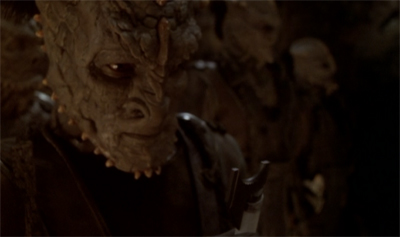
A Jem in the rough.
More than that, there is a legitimate argument to be made this minor creative disagreement enriched the show. Berman and Behr both had good intentions, and were both acting in what they felt to be the best interests of the series. Berman’s conservatism was rooted in the fear that the Star Trek franchise might slip from the mainstream and become a niche property. Behr’s concern was that the Star Trek franchise might grow stale unless it was willing to try new things. Both arguments make a certain amount of sense.
After all, both Berman and Behr were veterans of television production. There was no massive imbalance in terms of power and experience like there would be when Brannon Braga took control of Voyager. Indeed, it could reasonably be argued that Berman’s reluctance and hesitation forced the Deep Space Nine writing staff to justify their storytelling choices in those instances where there was some conflict over the best direction to take.

Serial hero.
The length of the Dominion War was one such point of contention, with Berman and the writing staff arguing over how long the war should last. According to Ronald D. Moore, the writing staff came up with a rather disingenuous solution to this disagreement:
“I remember when we got into the Dominion War, Rick was adamant at first that the war would only take three or four episodes at the most, and we just said, ‘Sure!’” Moore said. “We lied.
“We just knew that once we got the ball rolling, that we’d never wrap it up in three or four episodes, so that was just trickery. And then, as the war went on, Rick would weigh in periodically about how heroic the characters are, and ‘Why does this one have to be so depressing’ and ‘This one’s too violent …’ And we’re like, ‘It’s a f#%kin’ war! What do you mean it’s too violent?’”
This myth has grown in the telling, occasionally portraying Behr as a quick-witted Thomas Magnum trying to slip past Berman’s Higgins. Still, there is no denying that the Dominion War went on much longer than Berman intended.
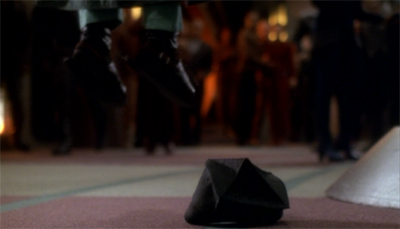
Hat’s off to them.
Indeed, the original promise for the Dominion War arc was three episodes. Then it became four. Then it was five, but Favour the Bold was so large a story that it had to be broken out into two parts. Even then, the writing staff cleverly wrote their way out of the problem presented to them. Although Sisko retook the station and defeated Gul Dukat in Sacrifice of Angels, the production team made it clear that the Dominion War was continuing in the background. It just happened that Deep Space Nine was no longer a battleground of itself.
There were any number of disagreements between Behr and Berman over the direction that the show took in these final two seasons, right down to specific story points. When Terry Farrell declined to return for the final season, there was considerable debate about how best to write Jadzia Dax out of the series. When Nog was wounded in battle during The Siege of AR-558, there was even an extended argument about just how badly the character could be wounded that ended with most ridiculous compromise.
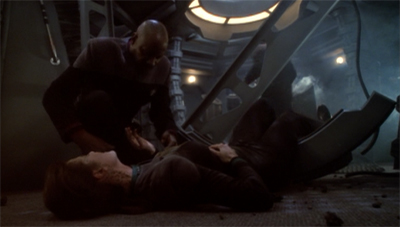
“Don’t worry, the writers would never kill you off in such an arbitrary and senseless manner. Certainly not without awkward foreshadowing in the episode directly prior.”
Of course, it is very easy to exaggerate these conflicts and turn them into something ridiculous. The truth is that most television shows are the result of creative compromise. Berman has acknowledged that he finds these rumours somewhat frustrating:
I’ve read a lot about tension between myself and Ira Behr and his writing staff on the show. I’ve read a lot about Ira pulling the wool over my eyes and Ira kind of tricking me into doing things that I didn’t want to do. I find that a little bit hurtful because it’s by and large not true. Ira had a very specific vision of how he wanted to run the show. This is after Michael had left. And there were certain things that I agreed with. In fact, a vast majority of what he and his staff did I agreed with. But there were certain things I didn’t agree with and, having been one of the two creators of the show and being an executive producer of the show, I felt I had the right to air my feelings to Ira. Unfortunately, it’s come out over the years as Ira tricking me into this or getting me to believe he was going to do X and then doing Y. I was never quite that foolish.
In fact, these sorts of rumours are often cited against Berman, as evidence of his alleged responsibility for the cancellation of Star Trek. There is something rather unfair about those criticisms, given the multitude of factors that contributed to the franchise’s decline.

“I think we can call this a wash.”
At the same time, it has been suggested that Berman’s occasionally difficulty keeping the Deep Space Nine writing staff in line with his vision of Star Trek might have contributed in some way to his management style on Voyager and Enterprise. By all accounts, Berman took a much proactive approach to micromanaging Brannon Braga on Voyager than he did towards Ira Steven Behr on Deep Space Nine. When the time came to produce Enterprise, Berman was frequently credited on teleplays.
In interviews after the end of Enterprise, Brannon Braga has talked about his thwarted ambitions for Voyager. The young (and relatively inexperienced) producer had originally envisaged two-parters like Future’s End, Part I and Future’s End, Part II or Year of Hell, Part I and Year of Hell, Part II as extended arcs in the style of these extended stories on Deep Space Nine. Braga’s vision was repeatedly compromised, with his big blockbuster two-parters serving as the boundaries of what would be permitted.

“And Janeway called her year the Year of Hell?”
In The Fifty Year Mission, writer Bryan Fuller suggested that Berman’s very conservative attitude towards Voyager was in some way a response to what was happening concurrently on Deep Space Nine:
I was coming into Voyager in Jeri Taylor’s last year, and so she was handing the baton over to Brannon, and Brannon was very much a new showrunner. There were things that he really wanted to do and should have been able to do, and which would have made the show better and bolder and bright, but he was not allowed to. Rick Berman more or less told him, “No, you can’t do that, because I can’t control Ira Behr on Deep Space Nine and I have to control you.”
This is a very revealing contrast, one that reveals a lot about the differences between Deep Space Nine and Voyager, even as the two shows were produced side by side.

A rocky road ahead.
History has been kinder to Behr than to Berman. Changes in media consumption have allowed Deep Space Nine to age much better than Voyager. The series holds up to the marathons and binge-watches of the DVD and streaming era, feeling almost like a show balancing between the end of the twentieth and the start of the twenty-first century. In fact, when binge-watched, the six-episode arc that opens the sixth season stands as one of the most ambitious and enjoyable Star Trek stories ever told.
In contrast, Voyager often felt dated as it was airing, and feels particularly dated when watched in hindsight. Fourteen years pass between Encounter at Farpoint and Endgame, but there is little appreciable sense of progress of evolution in the way that Star Trek constructs narratives. In contrast, only four months passed between the broadcast of Call to Arms and A Time Stand, but there has clearly been a tangible progression in how Deep Space Nine tells stories. Deep Space Nine aged well, as Behr predicted that it would.

The heat is on.
If I saw Rick Berman on the street today I would hug him. We ran into each other during the writers’ strike and we hugged. Did we agree all the time? No. Could we talk about that? Sure, we could, but what’s the point? Given the fact that we were part of this monolithic franchise, DS9 pushed the envelope as far as we could at that time in that situation. Could we have gone farther? Sure. Would the fans have gone with us? Not all of them, clearly. On a day-to-day basis I would say over the course of seven years we had a pretty good working relationship. We disagreed on lots of small and large things, but he went in there with me to fight for Avery Brooks, to shave his head and keep the goat. We walked across the lot together to the executive offices. We were jazzed and we had this disk of how he looked, and we were a team to do that. We got there and they immediately gave up, which was funny after three years. We were all set to go in with guns blazing and they said, “OK.” So it was a little anticlimactic, but we were a team at that moment. It’s one of the things that profoundly confuses me about the whole Star Trek (experience), is my relationship with Rick Berman, why people care or what that even means, what my relationship was.”
This is a very classy and pragmatic perspective on their relationship, and one that speaks to both Behr and Berman as professionals who understand the dynamics of the industry within which they work.
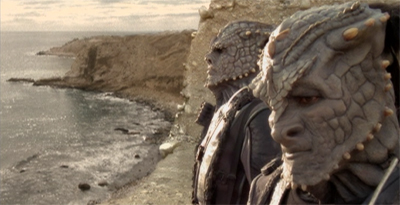
Shipwrecked.
And so the sixth season brings a more heightened and interconnected form of serialisation to Deep Space Nine. The six episodes that open the season consciously and organically lead into one another, with events in each playing across into the next. However, there are stronger and broader continuity ties from these six episodes to stories from earlier in the run and foreshadowing of plot developments yet to come. There is a sense that Deep Space Nine is being bound together in a manner much tighter than it had been.
The Jem’Hadar craft from The Ship is quite useful in A Time to Stand. Nog and Garak discuss Empok Nor while Sisko relates the events of To the Death to Remata’klan in Rocks and Shoals. Martok references the events of In Purgatory’s Shadow and By Inferno’s Light in Sons and Daughters, while Odo makes it very clear to the Female Changeling that he has not forgotten the events of Broken Link in Behind the Lines. Even minor continuity threads build across the episodes and beyond, like Damar’s alcoholism as first suggested in Behind the Lines.

Kee(van) details.
Still, the production team take great care to ensure that each of the six episodes can stand on their own term. Each episode in the arc represents its own discrete unit of story. Unlike a lot of modern prestige drama, there is a minimal attempt to tell multiple stories at once. Worf barely appears in A Time to Stand, and does not appear at all in Rocks and Shoals, but he then gets to single-handedly carry the primary plot of Sons and Daughters. Similarly, the ruling powers on Terok Nor are entirely absent from Rocks and Shoals, despite appearing in the rest of the arc.
Each episode in the six-part story accomplishes something of itself. A Time to Stand has the raid on the Jem’Hadar ketracel white facility. Rocks and Shoals has the ground war between Sisko and Remata’klan. Sons and Daughters juxtaposes Worf’s interactions with Alexander against Kira’s relationship to Ziyal. Behind the Lines splits its focus between Dax’s first mission in command of the Defiant and Odo’s seduction at the hands of the Female Changeling. Favour the Bold pushes everything to the brink, and Sacrifice of Angels pushes it all over the edge.
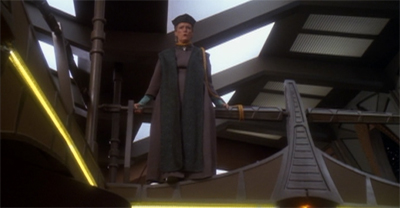
Pro-protest.
As explained in The Star Trek: Deep Space Nine Companion, the writing staff worked hard to ensure that each episode retained a distinct identity even with everything else going on:
The writers though they had a pretty good idea of where they were going after the initial break sessions. “We wanted to do one show about the war, so we all sat down and watched None But the Brave, the 1965 Frank Sinatra movie,” Behr recalls. The film, which deals with the interactions of the crew of a downed American plane and a Japanese army patrol during World War II bears “certain similarities”, he allows to the team’s planned ground war episode, Rocks and Shoals. Beyond that, he says, “we knew that Favour the Bold and what became Sacrifice of Angels were going to be the big broad-canvas shows. And we knew that we wanted to do Behind the Lines, which would be a show about being on an occupied station.”
This is a smart approach, and one that helps the storytelling a great deal. In fact, episodes like Rocks and Shoals and Behind the Lines stand out as some of the best storytelling Deep Space Nine has ever done, and can be enjoyed whether as part of a six-episode-marathon or even on their own terms.
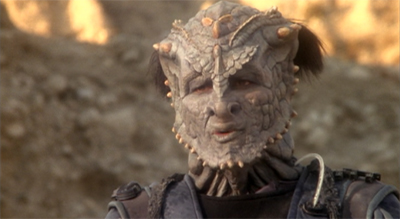
Must try Hadar.
This is in some ways an important distinction. This six-episode opening arc would not be the last time that Deep Space Nine attempted a storytelling experiment this bold and audacious. The series would close out its final season with a ten episode arc that brought the Dominion War to an epic conclusion while wrapping up most (if not all) of the dangling story threads. It is undoubtedly a breathtaking piece of television in the context of the late nineties, enough to qualify as a full season of modern prestige television.
However, that closing arc does not work quite as well as this opening arc. There are various reasons for this; it is generally easier to begin a story than to end it, certain pacing issues affect the ten-episode arc, some very basic storybeats are missed in the rush to tidy everything up. However, there is also a sense that the closing arc doesn’t balance the demands of individual episode against the needs of the larger arc. Too often in the final arc, it feels like the series is trapped between one extreme and the other.

Nerys-ing the end of her rope.
Many of the episodes in Deep Space Nine‘s final arc tend to blur into one another. There are exceptions, of course. When It Rains… and Tacking Into the Wind form a stealth two-parter buried in the larger arc. Extreme Measures is very clearly one last Bashir and O’Brien buddy comedy episode that neatly wraps up the lingering Section 31 threads and The Dogs of War tidies away the series’ long-standing interest in the politics of the Ferengi Alliance. However, it is very difficult to distinguish the first four episodes of the sprawling arc from one another.
Rocks and Shoals might depend on the events of Call to Arms for its status quo and pick up (almost) directly from the climax of A Time to Stand in terms of plot, but the episode very clearly tells its own story on its own terms. Following a daring raid into Cardassian territory, Sisko and and his crew find themselves trapped on a harsh planet facing a platoon of stranded Jem’Hadar soldiers. What follows is a meditation on the morality of war, and the strength of loyalty and duty in the face of simple reality.

Dirty tactics.
As with Hippocratic Oath and To the Death before it, Rocks and Shoals finds a perverse integrity in the Jem’Hadar. These genetically-engineered drug-addicted fighting machines are presented as the ultimate soldiers, but soldiers who appear to be developing their own strange concepts of honour. These are the soldiers who fight the wars dictated by the Founders and directed by the Vorta. The Jem’Hadar are the soldiers who die face-down in foreign soil in service of those born to higher stations.
The Dominion War is heavily influenced by the Second World War in terms of tone and aesthetic. After all, the Cardassian Union and the Dominion are both clearly analogues for Nazi Germany, with the black and white morality of the Federation’s opponents evoking the moral clarity of that defining twentieth century conflict. However, other influences do creep in around the edges. The Vietnam War is an obvious influence on episodes like The Siege of AR-558, for example, even if the script includes some Second World War ballads.

Make war, not love.
There is something of the First World War in the portrayal of the Jem’Hadar in Rocks and Shoals, the idea of masses of lower-class grunts laying down their lives at the direction of those perceived to be their social betters. After all, what is the Dominion’s genetic engineering but a rigid encoding of a class structure? It recalls the narrative of the First World War that was popularised by the anti-war historians of the sixties, arguing that it was a war fought by the working class on behalf of the political establishment.
This view holds considerable sway over depictions of the war in popular culture. It is evident in the idea of the British army as “lions led by donkeys”, and is treated as black comedy in films like Oh, What a Lovely War! and television series like Blackadder Goes Forth. These have become cultural touchstones for the discussion of the First World War, informing the popular perception of it. There remains some debate over this interpretation of the First World War, with some suggesting that the reality was more complex.

Face of the enemy.
While more members of the working class did die in service of the United Kingdom, the counter-argument suggests that this was simply a matter of harsh mathematics; more working class soldiers dies because the working class made up a greater percentage of the population at large. The matter is a source of controversy in the United Kingdom, with people like Michael Gove objecting to the narrative of the conflict as “a series of catastrophic mistakes perpetrated by an out-of-touch elite.”
Of course, the truth might be more complex than the broad stroke narrative that has built up around the conflict. However, there is no denying that one of the great tragedies of the First World War (and many other wars) is the sad reality that those who die in service of their country are rarely the ones to benefit from the war. This tends to get lost in the noble myths that build up around such conflicts. This is also true of African Americans who served in the American armed forces in the Second World War, or during the Vietnam War. It is universal.

‘klan warfare.
As such, there is something potent in the portrayal of the Jem’Hadar in Rocks and Shoals. Remata’klan is a compelling and intriguing character, particularly given the pettiness on display around him. When Limara’son suggests that Remata’klan is now the unit leader, Remata’klan corrects him. “I questioned the Vorta’s orders,” he explains. “He will not forget that. As long as he lives, I will remain Third.” It is not the worst thing Keevan does, but it is perhaps the most petty. And, yet, Remata’klan serves with distinction.
Indeed, the closing scenes of the episode almost play out in homage to the iconic closing moments of Goodbyeee, the closing episode of Blackadder Goes Forth. In that iconic episode, the title characters of the series all go “over the top” and wander into no man’s land. They know that this means certain death, but they simply have no other option. Goodbyeee is a bleakly nihilistic depiction of the Great War, a condemnation of the folly of war and an acknowledgement of its grotesque farce. Honour and duty mean nothing, abstract concepts used to justify atrocities.

Garak-ed with guilt.
The final scene, as Remata’klan marches his men into battle echoes that depiction of the First World War, although Remata’klan does not even make a token gesture of trying to resist his fate. “Do you really want to give up your life for the order of things?” Sisko challenges. Remata’klan responds simply. “It is not my life to give up, Captain. And it never was.” As the lone figure of the Vorta Keevan wanders through the dust cloud kicked up by the ambush, it provides a nice visualisation of the moral fog of wall, while also recalling the mist at the end of Goodbyeee.
It is a powerful and visceral piece of television, one that plays as a response to many of the criticisms of the Dominion War as a concept. Many fans and critics were shocked by the decision to portray an interstellar war on Star Trek, perhaps worried that Deep Space Nine might glorify or trivialise the realities of combat. Rocks and Shoals demonstrates a more nuanced perspective. Sisko’s decision to participate in the ambush and massacre of an enemy that refuses to surrender is portrayed as something logical, but also something horrifying. It is not heroic and valourous.

They’ve got this covered.
A large part of this is down to the performance by veteran Star Trek guest star Phil Morris as Remata’klan. In an interview looking back over his career, Morris acknowledged a fondness for the material that he was given in his various guest shots:
I’m not a Trekker or Trekkie or whatever you call them. I’m just an actor who enjoys great work, and when you play on Star Trek, in any iteration or variation of it, you’re gonna be guaranteed to be given amazing material, passionate, high stakes to play. And I got that in every episode I did.
Morris is fantastic in the role of a soldier who is so committed to his duty that all other considerations, including his will and his life, must be treated as secondary.
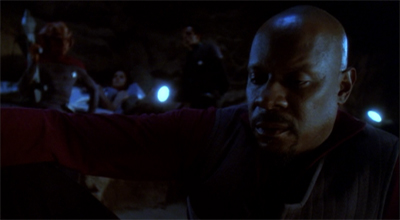
How far will Sisko go?
Rocks and Shoals benefits from a great guest cast. Morris is wonderful as Remata’klan, but he is gamely assisted by Christopher Shea as Keevan. In some ways, Keevan feels very much like the first Vorta to have been conceived and developed after Jeffrey Combs got to define Weyoun. Technically, Kaitlin Hopkins played Kilana in The Ship a few months after Combs made his debut in To the Death, but there was still a sense that the production team were struggling to find a proper voice for the species.
Eris, Borath, Weyoun and Kilana never really felt like they were cut from the same cloth as one another; no other Vorta would every demonstrate Eris’ telepathic abilities from The Jem’Hadar, while no other Vorta would demonstrate as short a temper as Borath in The Search, Part II. In contrast, Keevan feels very much like he belongs to the same species as Weyoun. The two exude the same sort of smarm and disdain for other people, along with a clear affection for the sound of their own voice.
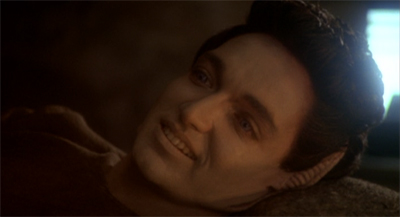
Smiles to go, before he sleeps.
Of course, Weyoun and Keevan are very clearly distinct characters. There are obvious differences between Weyoun and Keevan, in that Keevan seems a lot more self-interested and irreverent about the Dominion than Weyoun. However, there is a sense that the production team have finally figured out what makes the Vorta unique, what gives them a voice distinct from that of the Founders or the Jem’Hadar. Keevan and Weyoun are both recognisably Vorta in the same way that Martok and Gowron are recognisably Klingon.
The loyalty and devotion of the Jem’Hadar is pointedly contrasted with the selfishness demonstrated by Keevan. The Vorta official in charge of the stranded Jem’Hadar platoon is primarily motivated by his own survival. He cannot even be bothered to pantomime the rituals of devotion around which they have built their lives. “Obedience brings victory,” Remata’klan prompts. Keevan eschews the “… and victory is life” response, opting for a simple, “Yes. Yes, it does.” Keevan is a delightfully slimy character, unworthy of the authority instilled in him.

Ol’ blue eyes…
(Indeed, Keevan’s disregard for the rituals taken so seriously by the Jem’Hadar provides an effective juxtaposition with Weyoun. It recalls the impatience demonstrated by Weyoun IV when asked to distribute ketracel white while eating dinner in To the Death. However, it also provides a nice contrast with the devotion demonstrated by Weyoun V when hosting the same ritual in A Time to Stand. It seems like, on the sliding scale of Vorta cynicism, Keevan falls closer to the previous version of Weyoun than the current incarnation.)
The dynamic is all the more tragic for the fact that Remata’klan desperately wants to believe in Keevan, even though he knows that he cannot. He is well aware of Keevan’s shortcomings, but continually acts as if believing that he will be proven wrong. When Keevan outlines his plan, Remata’klan replies, “I understand.” Keevan responds, bluntly, “No, you don’t. But that’s all right. It’s not important that you understand, only that you carry out my instructions precisely.” Remata’klan’s response of “obedience brings victory…” almost seems like a gesture of goodwill after a snide putdown.

Point of principle.
Christopher Shea’s performance is fantastic, building a wonderfully odious (and yet entirely understandable) character with relatively little screen time. Keevan is hardly the most nuanced character to appear on the show, but Shea invests him with enough personality that he feels fully formed. There is a delightful non-chalance to Shea’s delivery that contrasts well with Morris’ earnestness. There is a sense of cold detachment from his responsibilities that plays very effectively as a counterpoint to his subordinate’s unwavering devotion.
This is particularly apparent in his scenes dealing with Sisko. “I’m ordering the Jem’Hadar to attack your base camp in the morning,” he bluntly informs Sisko. “But I will provide you with their precise plan of attack. You should be able to kill them all.” Bashir reacts with horror. “They’re your own men.” Keevan doesn’t even blink at the implied horror of that statement. “Yes,” he states simply, as if responding to a very basic question of fact. It seems almost as though Keevan believes that it goes without saying.

All fired up.
Indeed, Shea makes Keevan so wonderfully sleazy that the audience almost roots for Sisko as he considers just phasering the prisoner of war as he strolls through the carnage that he has wrought. That small character touch was not in the original teleplay. According to writer Ronald D. Moore, it was improvised during filming by actor Avery Brooks. Then again, a lot of the episode had to be improvised, including Dax’s injury in the teaser. According to Moore:
Terry has a skin condition that prevents her exposure to direct sunlight. We’ve worked around it in the past, but the large number of exterior scenes in Rocks and Shoals made it impossible this time. (The days we went on location this year were also some of the very hottest and most miserable days of the year, by the way, and the entire crew was suffering in that airless, baking rock quarry, not to mention the actors forced to work in already stifling makeup and appliances.)
Indeed, when Farrell was on location for the scenes early in the episode, the actor would use a parasol to keep her out of the sunlight; this made her the subject of considerable mockery from the cast and crew working in the scorching heat and burning sunshine. That plot modification is a great example of the sort of tweaks that the production team had to make to their scripts as they were going along, something obviously even more difficult in the context of a longer arc.
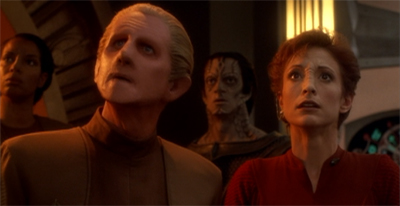
Don’t leave her hanging.
This sort of improvisational on-the-fly thinking had always been one of the strengths of the Deep Space Nine writing staff, particularly in the middle seasons. Although the Maquis had originally been intended to serve as a launch vehicle for Voyager, the writers on Deep Space Nine used them to tell all manner of interesting stories. When the studio vetoed a third season cliffhanger, The Adversary was written at short notice. When the studio insisted upon involving the Klingons, it led to The Way of the Warrior.
The writers on Deep Space Nine always seemed to have a rough idea of where they wanted to go with the series, but their plan was never mapped out in too much detail. There was always freedom and leeway to work around outside and unplanned factors. However, this approach would create some challenges during the sixth and seventh seasons of Deep Space Nine, particularly when it came to tying it all together and embracing a more serialised model. Indeed, the writers would brush up against these issues particularly when plotting Sons and Daughters and Behind the Lines.

“I think we may have voided the warranty.”
Indeed, Rocks and Shoals was retroactively affected by these plotting issues. The episode originally had a very different subplot on Terok Nor, but it had to be adjusted as the station plot in Sons and Daughters began to take shape. As Moore confessed to The Star Trek: Deep Space Nine Companion:
“The station storyline on “Sons and Daughters” changed while they were doing it, which meant that my station-based storyline had to reflect that change… we couldn’t keep it straight in our heads and we kept stepping on each other. Had something already happened, or was it happening the following week? It became very difficult to get the whole thing under control.”
In some respects, this can be seen. Kira’s subplot is told effectively, but it is also very much truncated. Dukat, Weyoun and Damar do not appear. Scenes are short, the transitions abrupt. There is arguably only the vaguest thematic overlap between primary and secondary plot, in contrast to the arc’s other stories.
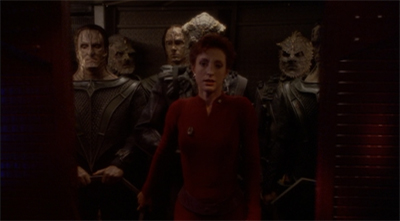
Lifting her spirits.
To be fair to Moore, the station-based subplot in Rocks and Shoals works very well. It certainly works a lot better than the similar plot thread in Sons and Daughters, which largely covers the same ground in a much clumsier manner. Kira’s moral crisis and awakening in Rocks and Shoals is executed in a very lean and effective manner, particularly the wonderful contrasting “a day in the life” montages at the start and the end. Unlike the station-based plot in Sons and Daughters, the subplot in Rocks and Shoals manages to convey a lot in a very efficient way.
Rocks and Shoals is a superb addition to the larger Dominion War arc and a wonderful episode in its own right. It is a fantastic demonstration of just what Deep Space Nine can do when it pushes itself, already delivering on the potential of one of the franchise’s most ambitious story arcs.
You might be interested in our reviews of the sixth season of Star Trek: Deep Space Nine:
- A Time to Stand
- Rocks and Shoals
- Sons and Daughters
- Behind the Lines
- Favour the Bold
- Sacrifice of Angels
- You Are Cordially Invited…
- Resurrection
- Statistical Probabilities
- The Magnificent Ferengi
- Waltz
- Who Mourns for Morn?
- Far Beyond the Stars
- One Little Ship
- Honour Among Thieves
- Change of Heart
- Wrongs Darker Than Death or Night
- Inquisition
- In the Pale Moonlight
- His Way
- The Reckoning
- Valiant
- Profit and Lace
- Time’s Orphan
- The Sound of Her Voice
- Tears of the Prophets
Filed under: Deep Space Nine | Tagged: deep space nine, Dominion War, Ira Steven Behr, Rick Berman, rocks and shoals, ronald d. moore, serialisation, star trek, star trek: deep space nine |




















Easily one of my favorite Star Trek episode.It is one of the few Star Trek episodes where the B plot is just as powerful as the A plot. I think the moment where the Vedek hangs herself is one of the most chilling moments in Star Trek. I also really like the juxtaposition of Kira’s two mornings, as I always appreciate whenever Star Trek goes into non-verbal storytelling. It is too bad that the next episode has Kira go through the exact same arc of realizing that she is becoming a collaborator, as it undercuts the power of this episode.
“This is also true of African Americans who served in the American armed forces in the Second World War, or during the Vietnam War.” Sadly, not just those wars, but the American Civil War and World War I as well. 179,000 African Americans served during the Civil War for their freedom, and though technically freedom was achieved, the eventual process of Reconstruction led to hardship for the African American community in the years to come. Also, in WWI, over 200,000 served with regiments, such as 369th received equal acclaim for its combat performance,as well as being the first American troops to reach the Rhine. What was the reward of the African Americans who served in WWI? Increased racial violence as there were 83 lynchings in 1919 with at least 11 being soldiers from the war. Furthermore, in October 1919, whites in Elaine, Arkansas, massacred hundreds of black people in response to the efforts of sharecroppers to organize themselves.
Yep, you’re entirely right. It’s not as if those experiences are unique to the Second World War or Vietnam. The figure of the “soldier who will never be treated as anything more than meat for a grinder” is sadly universal, but I think it taps into the poignancy of the Jem’Hadar as a concept, the soldiers who die in service of gods indifferent to their suffering.
In comparison to Babylon 5, which excels in ways that DS9 faltered, I think Ron Moore did a better job of capturing Army life. Better, it felt like after years and years of teasing, we’re finally on “the frontier”.
The hardships of location shooting meant that these episodes are rare…and sparkle in ways that controlled shoots in an a/c studio don’t.
The shot of Keevan strolling along with his drug briefcase. Very “Lord of War.” One of the best shots of the series, no special effects needed.
One more thing I want to point out. Garak with a combadge. This is a great gag. The more he identifies with the Federation, the less effective he becomes.
You keep waiting for Garak to inevitably don a Starfleet uniform like every alien character before him (and after him), but nope.
That’s a good point. I do love that small moment where Garak tries to talk his way out of the situation and Keevan (who is bleeding to death at this moment) still makes a point to interrupts him in the smuggest manner possible.
Ed, Keevan strolls onto the battlefield not with the last supply of Ketracel White but the comm unit they need to signal for help.
A very interesting review about a very interesting episode. I have to admit the First World War analogy hadn’t occurred to me before.
I’ve seen statistics (from Niall Ferguson and others) that point out the British officer class actually suffered disproportionately heavy casualties compared with the men who served under them so I very much take the ‘Lions led by Donkeys’ myth with a grain of salt. I think I’ve pointed out before that of the leaders of the three big British political parties in 1914 – and it is difficult to think of more elite – Asquith had a son killed at the Somme, Bonar Law lost two of his sons and John Redmond (whose son served on the Western Front but survived) lost his brother.
Yep. I suspect there is a broader “truthiness” to that sentiment, for lack of a better word. The statistics might suggest an equivalence, but there’s also the fact that the lower classes are MUCH larger. So there’s a sentiment that on that scale the proportions don’t quite capture the sentiment. I mean, it’s reasonable to argue whether that’s fair, but I suspect that’s a large part of what that sentiment is rooted in.
Interesting that you didn’t note that the shooting location for the episode was the same hellish quarry used for “The Ship”, which means the captured Jem’Hadar ship ends up, in a way, right back where it started.
Also, in terms of metaphors, I’ve read that Vedek Yassim’s suicide was inspired by the Buddhist monk(s) that committed suicide via self-immolation in protest of the Vietnam war.
Ha! I had never noticed that. A nice bit of symmetry there! And in the second episode of consecutive seasons… well, broadcast-wise, at any rate.
The actress playing Yassim was the daughter of Holocaust victims too. I think.
I think you did make the connection in your review of The Ship Darren. But yeah, it is a nice bit of symmetry – events in DS9 always seem preordained to me.
Yep. DS9 has a nice symmetrical structure, even if it developed by accident. The echoing of The Visitor in What You Leave Behind is one such example.
Rocks and Shoals continues a trend of honourable Jem’Hadar that we’ve seen in episodes like Hippocratic Oath, To the
Death and By Inferno’s Light and Remata’Klan may be the best example yet. Even suffering the effects of Ketracel White withdrawal, Remata’Klan remains quite personable and keeps his word in each of his dealings with Sisko, while at the same he retains his loyalties to the Dominion, even in the face of overwhelming defeat.
This is neatly contrasted with Keevan who wouldn’t know honour if it shook him by the hand. He’s more than willing to surrender as a POW, even if it means trading the lives of his own soldiers just so he can arrange passage off of this world and ensure security for himself. We’ve always known the Vorta lacked a backbone, but Keevan is the slimiest one we have yet to encounter and gets a well-deserved comeuppance in The Magnificent Ferengi (his second encounter with Nog).
This is the first of Dax’s brushes with death this season, with the next in Change of Heart, until finally her luck runs out in Tears of the Prophets. Her injury in Rocks and Shoals was driven more by necessity than artistic licence, but it does foreshadow Terry Farrell’s departure from the series everytime I see them.
Even in such a grim episode with multiple deaths and public suicide, it’s nice that Rocks and Shoals can make time for a moment of levity when O’Brien cracks everyone up after he starts whining about tearing a pants leg on the long swim to shore after their ship crashed into the sea.
DS9 didn’t see a DVD release until 2003 – the series ended in 1999 so that was four years instead of three; isn’t it a three-month wait between seasons; you say Favour the Bold pushes everything to the bring, but I think you mean brink Darren.
Thanks David. Those corrections have been made. And Keevan’s two appearances are a nice example of how subtly confident DS9 is getting with long-form storytelling and carrying continuity.
I wish I could say that I admired this episode. It had potential. But I thought its execution seemed off base. It was like watching two completely different episodes shoved into one. The clumsiness of this episode reminded me why I wasn’t that impressed with the whole arc regarding the Dominion/Cardassian occupation of Deep Space Nine. It did not quite live up to its potential.
I quite liked the a-plot/b-plot dynamic myself, juxtaposing the reality of life on the front with Kira’s own relatively sheltered position on an outpost well behind the lines. Watching the characters struggle and suffer helps sell Kira’s frustration at the comforts with which she has surrounded herself.
I strongly agree-and think that Rocks and Shoals deserves a spot in the Top Ten DS9 episodes, if not the entire franchise. It’s precisely because of the symmetry. It doesn’t feel like two stories crammed into one. It feels like two stories that fit perfectly together and complement each other-like Treachery, Faith, and the Great River. Not to mention the superb script by Ronald D. Moore and Phil Morris’ engaging performance, and it adds up to a stone cold classic.